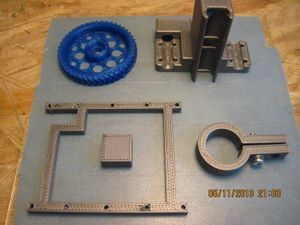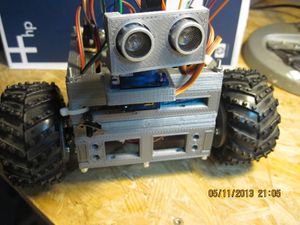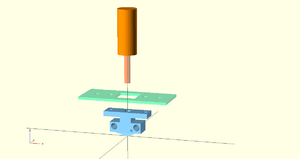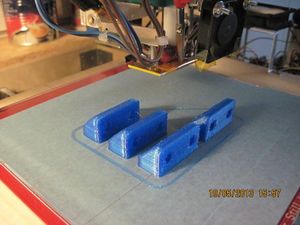DrillandFile Hot End
Making your own hotend is like baking your own bread - there might be professionals out there who can bake better and have superior gadgets to do so, but nothing compares to your own, self-made bread.
This hotend is just another attempt at designing a simple hotend which can be made DIY-style without the need for expensive tools, machinery and materials. It was inspired by the Watson_Hot_End, the KISS_Hot_End and the Wildseyed_Simple_Hot_End.
The basic idea is to drill first, then file in shape. That is, you take a rectangular block of aluminium alloy, drill the holes for the ptfe sleeve and the nozzle first, and then start filing the block into its final shape. That way, the drilling precision that can be reached with a simple drill press is not critical, you can more or less drill slightly off-center and still end up with a very precise hotend after filing.
Summary:
- electric tools required: drill press
- common hand tools required: saw, file(s), drill bits
- special hand tools required: hand chuck and 0.5mm or 0.3mm drill bits for nozzle
- materials required: aluminium bar 20x35mm for heater, PTFE round material 5mm and 15mm OD for insulator, 3mmx20mm steel bar for bracket
- vitamins required: 2 power resistors 6.8R, thermistor, high-temperature silicon caulk
- skills: drill, file and tap an M4 thread
The current version is v3 and works quite well. Besides printing calibration pieces and robotics parts, I have used it to print all parts for my Mendel90.
Contents
Status
The current version is v3 and works quite well. Besides printing calibration pieces and robotics parts, I have used it to print all parts for my Mendel90.
Here are some examples of prints made with v2 and v3 with a 0.5mm nozzle:
Component Overview and Functional Description
the main components are:
- heater block
- bracket
- insulator
Heater Block
The heater block is made from aluminum alloy. It has a central bore of 5mm for housing the PTFE insulator sleeve. The central bore goes almost through to the nozzle end (minus 1.5mm). The nozzle bore (0.5mm or 0.3mm for example) is made using a hand chuck and a drill bit from the other side, so it aligns with the nozzle bore. Additionally, there are two 5mm bores for the wire-wound heating resistors and a single bore of approx. 2mm for the thermistor. At the top of the heater block there are two M4-threaded 3.2mm bores for the fixing screws.
Note that the heater block has no thread or other fixing meansfor the insulator. The insulator sleeve will push-fit into the central bore with the bracket pulling the heater block against the main body of the insulator.
Also, despite its complex shape, the heater block is made from a single rectangular 20x35x12mm piece of aluminium alloy by simply drilling, cutting and filing.
Bracket
The bracket is made of ordinary steel (Baustahl) 2mm thick by 30 mm wide. Is has two bores for the fixing screws of the heater block and two bores for the M4 rods for fixing the whole hotend to the extruder (standard distance of 50mm for fixing to extruder). In the center, there is a cutout for allowing the insulator to pass through into the heater.
Insulator
The insulator consists of two parts: an inner sleeve of PTFE with an OD of 5mm and a main insulator body with an OD of 15mm. The main insulator body has a bore of 5mm for inserting the sleeve. Therefore, the insulator can be made without a lathe. All the is required are two rods of PTFE round material of 5mm and 15mm OD, respectively.



